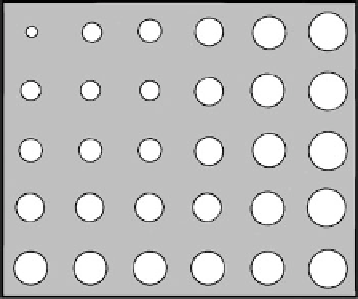Biomedical Engineering Reference
In-Depth Information
Fig. 7.5
An illustration
of a material with a unlayered
structural gradient. Spheres
of varying diameters and one
material type are graded in a
size distribution in a material
of another type. As a special
case, the spheres may be
voids. From Cowin (
2002
)
average over the microstructure and
also
small enough to insure that the structural
gradient across the RVE is negligible, then it is necessary to restrict the material
symmetry to accommodate the gradient. However, in a material with a structural
gradient, if an RVE may be selected so that it is large enough to adequately average
over the microstructure and small enough to insure that the structural gradient
across the RVE is negligible, then it is not necessary to restrict the material
symmetry to accommodate the gradient.
It is easy to see that a structural gradient is incompatible with a plane of
symmetry. If a given direction is the direction of a structural gradient it cannot
also be the direction of a normal to a plane of symmetry, nor any projected
component of a normal to a plane of reflective symmetry, because the increasing
or decreasing structure with increasing distance from the reference plane, such as
the layered spherical inclusions in Fig.
7.4
, would be increasing on one side of the
plane and decreasing on the other side of the plane violating mirror symmetry.
Gradient materials are thus a type of chiral material described in Sect. 4.9. Gradient
materials are chiral materials because they require that the material symmetries
possess at least one direction that is not a direction associated with a normal to a
plane of reflective symmetry, nor any projected component of a normal to a plane of
reflective symmetry. The point is that, on the same scale, the normal to a plane of
symmetry and a material structural gradient are incompatible unless they are
perpendicular. This incompatibility restricts the type of linear elastic symmetries
possible for gradient materials to the same symmetries that are possible for chiral
materials (Sect. 4.9), namely, trigonal, monoclinic, and triclinic symmetries (c.f.,
Fig. 4.10).
The normal to a plane of material symmetry can only be perpendicular to the
direction of a uniform structural gradient. The argument for this conclusion is a
purely geometrical one. First note that the direction of a normal to a plane of
material symmetry cannot be coincident with the direction of the structural gradient
because the structural gradient is inconsistent with the reflective structural symme-
try required by a plane of mirror symmetry. Next consider the case when the normal
to a plane of material symmetry is inclined, but not perpendicular, to the direction

Search WWH ::

Custom Search